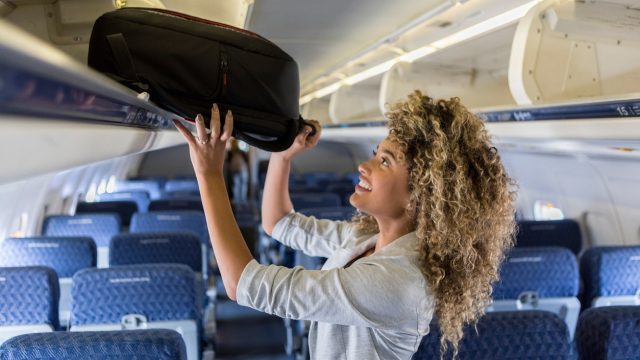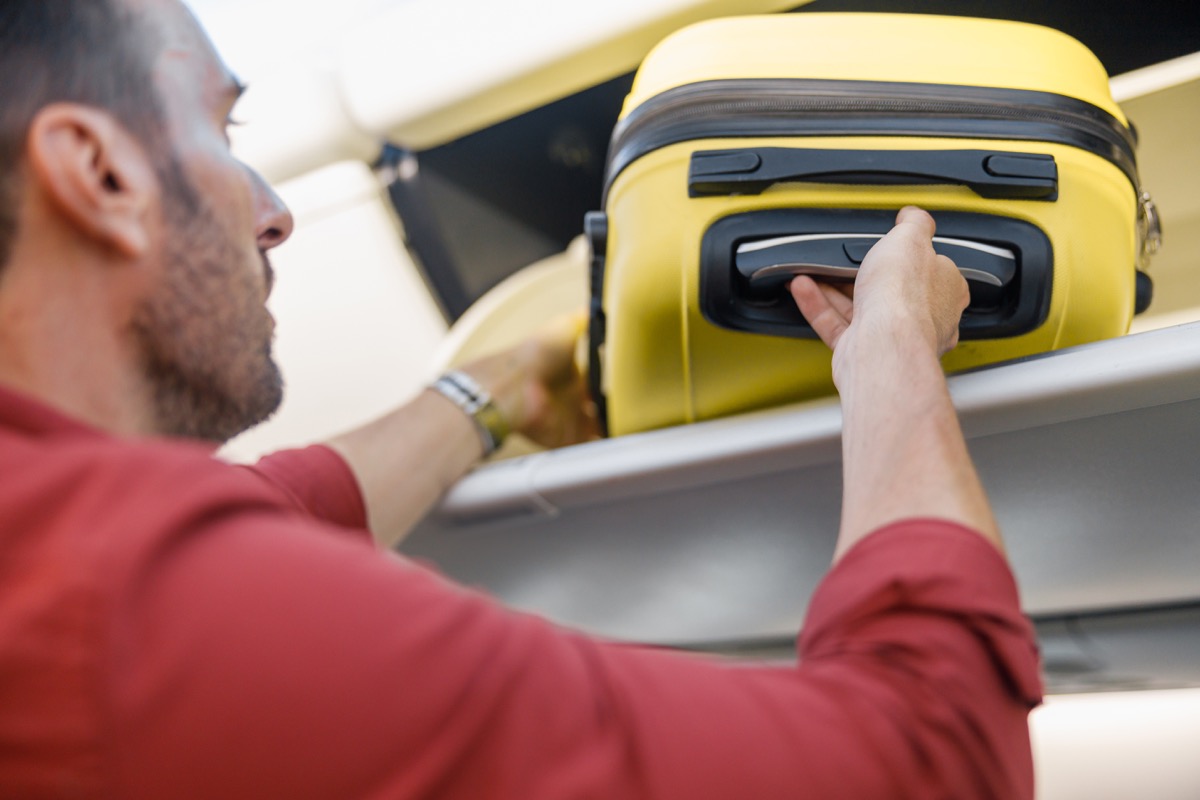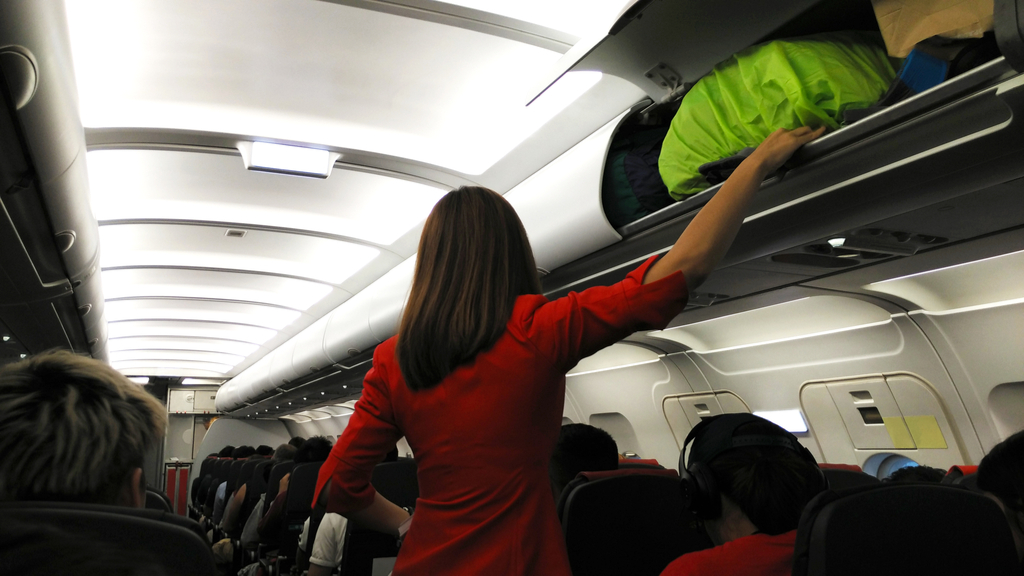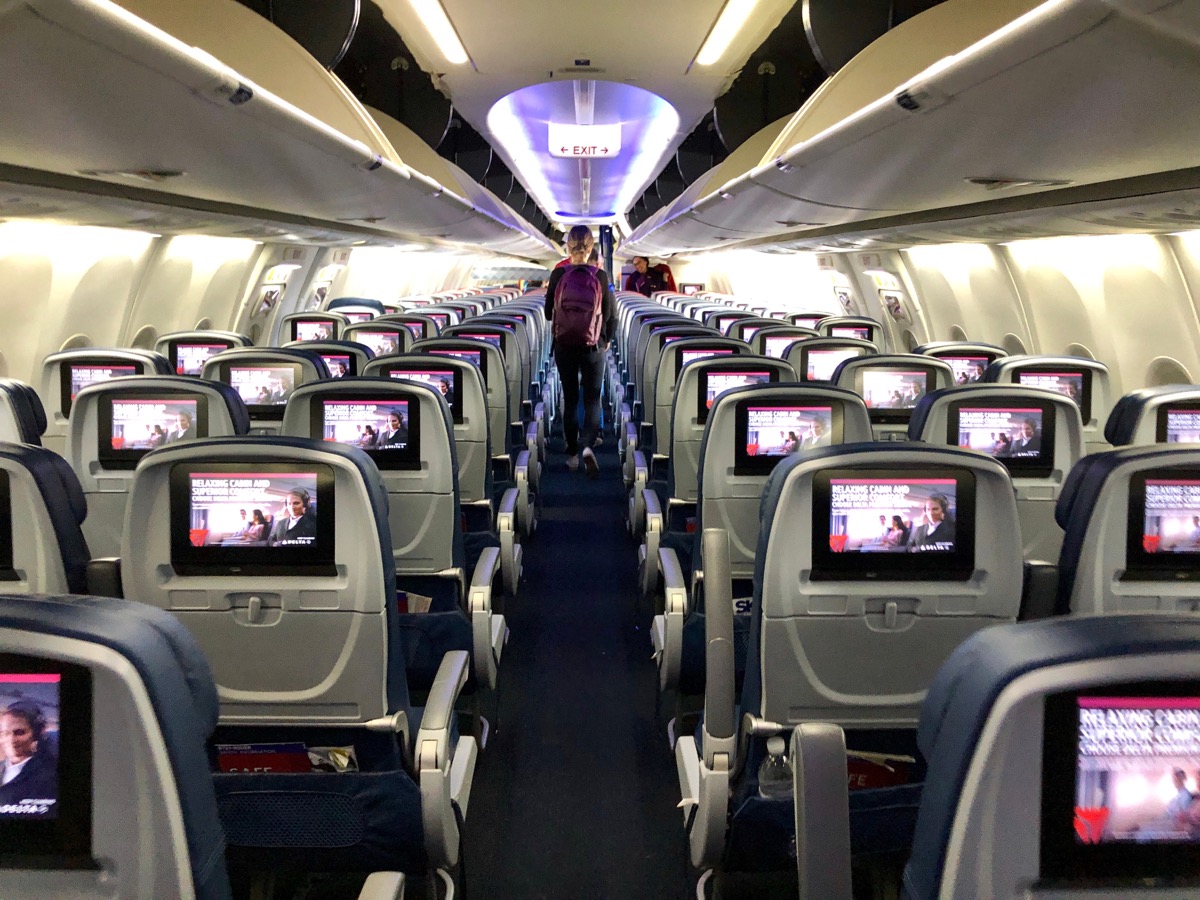The One Way You Should Never Stow Your Carry-On, Flight Attendant Says

Dealing with luggage can be one of the more stressful elements of traveling. Deciding to check a bag can make getting through the airport or security much easier, but there’s always the chance it might not meet you at your destination. Many flyers choose to keep their luggage with them for this very reason, even if they now face the risk of their plane running out of precious overhead bin storage space before they get to their seat. However, if you manage to make it all the way with your carry-on still in hand, flight attendants say there’s one way you should never store it. Read on to see what’s become a major flying faux pas.
READ THIS NEXT: Never Travel Without This Item, Flight Attendant Says.
There are benefits to not checking your luggage and sticking with a carry-on.

While the idea of toting your belongings with you all the way from home to your destination might seem miserable, there are plenty of good reasons to keep your bags with you besides the fear that your airline might lose them. Experts say that by deciding to travel with just a carry-on, you can make the entire travel experience much more efficient.
“Pack as little as possible,” Heidi Ferguson, a flight attendant with 20 years of experience in the commercial and private aviation industry, previously told Best Life. “If you can bring everything with you onboard in a small roller board and carry-on bag, do that. It saves tons of time after the flight with waiting at baggage claim or with customs. Most people overthink and overpack for trips and only end up using half of the items they pack.”
Ultimately, those who travel professionally know it’s best to lighten your load before you take to the skies. “I’ve been around the globe many times and have never had a problem purchasing something that I forgot to bring or picking extra odds and ends for my trip. Pack light and buy where you land if absolutely necessary,” Ferguson suggests. But you should still always remember to do one thing when you’re putting your bag away on the plane.
Flight attendants say there’s one way you should never stow your carry-on once you get onboard.

For a long time, it may have felt like the cramped overhead bins on planes were designed purposely to draw out fights among passengers vying for precious space. However, as major U.S. airlines refresh their fleets with newer aircraft, many have become aware that travelers are more likely to stick to a carry-on and have increased the size of the storage areas to accommodate them, The Wall Street Journal reports.
Fortunately, the changes have had immediate positive effects for some companies, with American Airlines saying it has seen a 30 percent decrease in bags checked at the gate since installing the bigger bins on more than 80 percent of their planes. But according to flight attendants, the new system will only work for everyone if all passengers remember there’s a new proper way to stow their carry-on after boarding.
“If you’re lucky enough to find yourself on a plane with the newer, taller bins, you can put them in wheels first, but on their side,” Heather Poole, a longtime flight attendant and author of the book Cruising ATTitude, told Travel + Leisure.
For more travel advice delivered straight to your inbox, sign up for our daily newsletter.
Airlines are using one delicious example to demonstrate the correct way to store your bag.

Old travel habits can be some of the hardest to break, even with plenty of reminders. Many airlines that have installed the larger bins have installed small diagrams at the back of each compartment reminding passengers to store their bags vertically, while many others still have to make repeated announcements during boarding to turn all carry-on bags on their sides, The Wall Street Journal reports.
“There is definitely a learning curve, especially for our less-frequent travelers,” Susannah Carr, a flight attendant for a major U.S. airline, tells The Wall Street Journal. “‘It’s not going to close,’ they say. ‘That’s not how bags fit in the overhead bins.’ I promise you it will close. Trust the process,” she tells passengers.
To better explain the new system to travelers, airline employees have begun using different methods to help better demonstrate and educate them. United Airlines posted a TikTok from its official account showcasing the correct way to stow carry-on bags. But for others, the most relatable item has been food, with one airline using the announcement: “The overhead bins are equipped so you can put your suitcases in there upright like a taco, not flat like a hamburger.”
Still, others are learning from their fellow travelers, especially from the frequent flyers who are more accustomed to the larger bins. “They’re doing a lot of the education for us, because they board early, they’re tipping up their bags,” Matthew Coder, in-flight experience program manager for Alaska Airlines, tells The Wall Street Journal. “And then others get on board, see those examples and tip them up.”
Check what type of plane you’re flying before you decide what type of luggage is best.

But even as the major carriers make more room for baggage onboard, it’s not always certain that you’ll have all the extra space new aircraft provide.
“I have complete empathy when people get a little confused with the overhead bins,” Carr tells The Wall Street Journal. “From one plane to the next, it changes.”
If you’re unsure about what to expect or which type of luggage to use, airline employees say it can help to check your flight information for what kind of aircraft you’ll be traveling on that day. “Every time I work on the Embraer 170 or 175 [regional jets], passengers comment on the smaller bin space and say, ‘It fit on the last plane,'” Beth Blair, a longtime flight attendant, wrote for the website 365 Atlanta Traveler. “Mainline and international flights usually have much larger equipment than regional aircraft, which means the bins are probably bigger, too.”
And ultimately, even if you’re afraid of spending extra time waiting for your belongings at baggage claim, sometimes handing your bags off as you get ready to board can save you from a costly delay on the front end. “It’s also not always possible to find a space for everyone’s bag, so your extra items may need to be checked regardless,” Arina Bloom, a flight attendant who worked in the industry for two years, wrote for Business Insider. “If you’re worried about paying extra, ask an attendant at the gate. They’re usually happy to check it for free if the flight is full.”